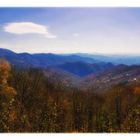springtime... (1)
... in the Great Smoky Mountains

springtime... (2)
Hans-Reiner Bohn
Impressions from Blue Ridge Mt. Parkway, April 2010
The Great Smoky Mountains are a mountain range rising along the Tennessee-North Carolina border in the southeastern United States. They are a subrange of the Appalachian Mountains, and form part of the Blue Ridge Physiographic Province. The range is sometimes called the Smoky Mountains or the Smokey Mountains, and the name is commonly shortened to the Smokies. The Great Smokies are best known as the home of the Great Smoky Mountains National Park, which protects most of the range. The park was established in 1934, and, with over 9 million visits per year, it is the most-visited national park in the United States.
The Great Smokies are part of an International Biosphere Reserve. The range is home to an estimated 187,000 acres (760 km2) of old growth forest, constituting the largest such stand east of the Mississippi River. The cove hardwood forests in the range's lower elevations are among the most diverse ecosystems in North America, and the Southern Appalachian spruce-fir forest that coats the range's upper elevations is the largest of its kind. The Great Smokies are also home to the densest black bear population in the Eastern United States and the most diverse salamander population outside of the tropics.
Along with the Biosphere reserve, the Great Smokies have been designated a UNESCO World Heritage Site. The U.S. National Park Service preserves and maintains 78 structures within the national park that were once part of the numerous small Appalachian communities scattered throughout the range's river valleys and coves. The park contains five historic districts and nine individual listings on the National Register of Historic Places.
The name "Smoky" comes from the natural fog that often hangs over the range and presents as large smoke plumes from a distance. This fog, which is most common in the morning and after rainfall, is the result of warm humid air from the Gulf of Mexico cooling rapidly in the higher elevations of Southern Appalachia.
source: http://en.wikipedia.org/wiki/Great_Smoky_Mountains










locke 1 30/04/2010 16:25
Malerisches Motiv!Fantastisches Farbenspiel, genau
das Richtige für meine Augen.
LG Werner
Dorothea Weckmann - Piper 28/04/2010 22:07
herrlich...lg dorothea
Michael Grotkamp 27/04/2010 17:33
starker Weitblick in diese geschichtsträchtigeBergwelt, sehr schöne Farbskala.
Gruß, Michael
Gasser Lisbeth 27/04/2010 15:36
Sehr schöne Landschaft, fantastische Farben !LG Lisbeth
Willewaller 27/04/2010 14:51
Das ist ein aussagekräftiges Bild.LG WW
Claudio Micheli 27/04/2010 13:22
....a very good view!Ciao
Mark Billiau. 27/04/2010 11:51
Wonderful view over the mountains !Mark
CsomorLászló 27/04/2010 11:45
Mag diese farben!!lg
CsL
Christian Rocher 27/04/2010 7:29
J'aime beaucoupchristian
Gunter Linke 26/04/2010 23:11
eine fantastische LandschaftGG
Auch der Frühling ist ein herrlicher Motivgeber
Wiesenimpressionen
Gunter Linkewkbilder 26/04/2010 22:33
fantastisch diese farbenpracht, vg peter